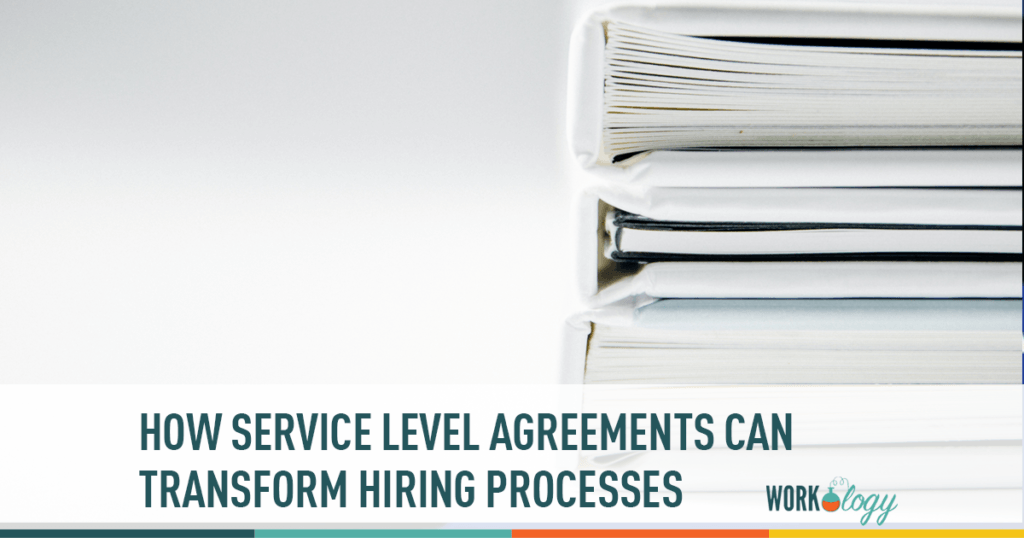Do you use SLAs in your hiring process? If not, here are some great reasons to consider doing so.
Starting with the recruiting intake call, which is typically the initial conversation between the hiring manager recruiter about an open role the recruiter is tasked with being filled. The purpose of the intake call is to set expectations, discuss the role, and determine if there are other important skills, experiences, or relevant abilities not outlined in the job description. During an intake call, the SLA or service level agreement is discussed.
In addition to an intake call to discuss the new position, a recruiter can deliver 2-4 candidates during the intake call or within 2 business days from position sourcing to discuss the types of skills, experiences, and qualifications these candidates who were sourced based on the job description and intake call are lacking.
The SLA or Service Level Agreement Defined
Service-level agreements, or SLAs, are simply formal written agreements between recruiters and hiring managers that spell out the expectations and the responsibilities of each party in the recruitment and hiring process. By spelling out responsibilities, timelines, deliverables and success measures in advance, SLAs outline who is responsible for what, and what timeframes are realistic. These agreements make communication easier, improve results and help to build strong hiring manager relationships. This is the key to hiring faster and gaining higher acceptance rates from your best candidates.
SLAs are essentially informal contracts that help facilitate conversations and help level set expectations focused on building a relationship between the hiring manager and recruiter. Both parties have a commitment in the hiring process and within the service level agreement are agreeing to commit to specific deadlines and promises such as candidate follow-up, time of interview, recruiter/hiring manager communication, and the giving and receiving of candidate feedback.
There is one prerequisite to SLAs: Buy-in from your hiring managers. SLAs won’t work if the relationship and the respect are not there first. SLAs have value even in just getting the conversation started with your hiring managers. Frame it as a process improvement that will serve both of your goals, and you can create that all-important buy-in.
SLAs in Hiring and Recruiting & Best Practices
Since the recruiting function doesn’t actually make hiring decisions, it is defined as a “service function” that provides services to hiring managers. Because great service delivery is essential in recruiting, it makes sense for recruiting leaders to follow the practices of other successful business service functions and to adopt service-level agreements.
Improve the quality of hires. SLAs have the added advantage of improving new-hire quality because the recruiting process is more consistent and predictable, reducing conflicts between recruiter and hiring manager. B
Speed up the recruiting process. By simply giving professionals (both recruiters and hiring managers) a deadline, most will make a strong effort to meet it. Additionally, an SLA dramatically reduces confusion and duplication. Remember, the average time to fill right now is in excess of 41 days.
Reduce hiring costs. Streamlining the recruiting and hiring process and eliminating redundancies will reduce the amount of valuable management time that must be spent on recruiting. In addition, your cost per hire will also go down.
Improve compliance. Having an SLA makes everyone more aware of precisely what steps to take, which should reduce legal risks related to unequal or disparate treatment.
Higher CEO and hiring manager satisfaction rates. When we understand each other’s expectations and processes, we work together better and are able to meet and understand expectations.
Back to the SLA
By measuring the actual time it takes to receive feedback, talent acquisition teams can often uncover critical bottlenecks in the recruitment process and avoid both delays and the potential loss of good candidates who get caught in “we don’t have an update for you” limbo.
Make sure you set and schedule follow up meetings and appointments. Hold both yourself and the hiring manager accountable.
Getting quick feedback from the manager about the quality of the submitted candidate slate is critical. I generally recommend an internal SLA of two business days for managers to provide feedback and a decision on candidates.
Finally, if the recruiter and hiring manager don’t understand each other, it can be incredibly costly. An unclear position leads to a mis-hire and can cost a client up to a third of the new hire’s salary to replace them. Avoid the disconnect between hiring managers and recruiters to save everyone time and headaches. Because in this competitive war for talent, recruiting best practices like this can really make a difference.









One Comment
Thank you! Do you have any data around SLA’s for requisition hygiene? For example, after the req intake, is it fair to say resumes should be submitted within 24 to 48 hours? What is best practice for dispositioning all candidates? Wait until the person hired actually starts? I’m looking to develop a goal for our entire company around requisition hygiene and the value behind such as compliance. Any guidance would be very helpful.
Comments are closed.